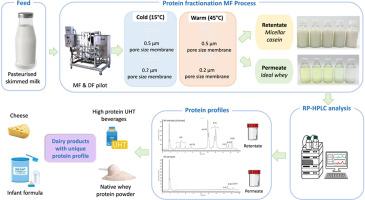Effect of pore size and temperature on the behaviour of alpha-lactalbumin and the A and B genetic variants of beta-lactoglobulin during protein fractionation microfiltration
IF 11
1区 农林科学
Q1 CHEMISTRY, APPLIED
引用次数: 0
Abstract
The aim of this study was to investigate the influence of membrane pore size and filtration temperature on six individual milk protein fractions (αS-CN, β- CN, κ-CN, α-LA, β-LG A, β-LG A) during the protein fractionation microfiltration process. Pasteurised skimmed milk was microfiltrated using two different pore sizes of spiral-wound membranes, with pore sizes of 0.2 μm and 0.5 μm, at temperatures of 15 °C and 45 °C respectively. The microfiltration process was carried out with a final volume reduction of 66% and a diafiltration volume of 120% (300 L) of the original feed (250 L). It was observed that neither the pore size nor the filtration temperature significantly (p < 0.05) affected the permeation of the α-LA fraction. However, the permeation of the β-LG A and β-LG B fractions can be influenced by membrane pore size and filtration temperature, and the behaviour of the three whey protein fractions, A and B genetic variants of the β-LG and α-LA fractions differs significantly during the microfiltration process. The results of this study could form the basis for the development of new, unique tailor-made milk protein ingredients.

孔径和温度对蛋白质分馏微滤过程中α-乳清蛋白以及β-乳清蛋白的A和B基因变体的行为的影响
本研究旨在探讨蛋白质分馏微滤过程中膜孔径和过滤温度对六种牛奶蛋白质组分(αS-CN、β- CN、κ-CN、α-LA、β-LG A、β-LG A)的影响。使用两种不同孔径的螺旋缠绕膜(孔径分别为 0.2 μm 和 0.5 μm)对巴氏杀菌脱脂奶进行微滤,微滤温度分别为 15 °C 和 45 °C。微过滤过程的最终体积减少了 66%,重过滤体积为原始进料(250 升)的 120%(300 升)。据观察,孔径和过滤温度对 α-LA 部分的渗透都没有显著影响(p < 0.05)。然而,β-LG A 和 β-LG B 两种馏分的渗透率会受到膜孔径和过滤温度的影响,而且在微滤过程中,β-LG 和 α-LA 两种馏分的三种乳清蛋白馏分、A 和 B 基因变体的行为也有很大不同。这项研究的结果可作为开发新的、独特的定制牛奶蛋白成分的基础。
本文章由计算机程序翻译,如有差异,请以英文原文为准。
求助全文
约1分钟内获得全文
求助全文
来源期刊

Food Hydrocolloids
工程技术-食品科技
CiteScore
19.90
自引率
14.00%
发文量
871
审稿时长
37 days
期刊介绍:
Food Hydrocolloids publishes original and innovative research focused on the characterization, functional properties, and applications of hydrocolloid materials used in food products. These hydrocolloids, defined as polysaccharides and proteins of commercial importance, are added to control aspects such as texture, stability, rheology, and sensory properties. The research's primary emphasis should be on the hydrocolloids themselves, with thorough descriptions of their source, nature, and physicochemical characteristics. Manuscripts are expected to clearly outline specific aims and objectives, include a fundamental discussion of research findings at the molecular level, and address the significance of the results. Studies on hydrocolloids in complex formulations should concentrate on their overall properties and mechanisms of action, while simple formulation development studies may not be considered for publication.
The main areas of interest are:
-Chemical and physicochemical characterisation
Thermal properties including glass transitions and conformational changes-
Rheological properties including viscosity, viscoelastic properties and gelation behaviour-
The influence on organoleptic properties-
Interfacial properties including stabilisation of dispersions, emulsions and foams-
Film forming properties with application to edible films and active packaging-
Encapsulation and controlled release of active compounds-
The influence on health including their role as dietary fibre-
Manipulation of hydrocolloid structure and functionality through chemical, biochemical and physical processes-
New hydrocolloids and hydrocolloid sources of commercial potential.
The Journal also publishes Review articles that provide an overview of the latest developments in topics of specific interest to researchers in this field of activity.
 求助内容:
求助内容: 应助结果提醒方式:
应助结果提醒方式:


